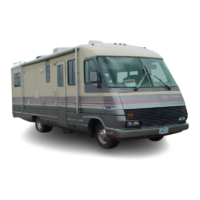LIQUID
PETROLEUM
GAS
SYSTEM
Liquefied
petroleum
(LP)
gas is available
from
an
approved storage
tank
to
operate
your
range, oven,
furnace, and
water
heater, and as an alternate energy
source
for
some refrigerators
•.
With
proper handling
precautions,
LP
gas is safe and provides modern con-
veniences wherever
you
travel. The
LP.
gas storage
tank is
mounted
on
the
moto,
home
chassis.
It
is
stored as a liquid
under
pressure and vaporizes under
the
control
of
a pressure regulator.
A typical
LP
gas
tank
InstllUa,tionIs Iuustrated
.belo":,",,
Although
specific
details
of
tfiesystemmay
differ
In
your
motor
home.
the
major components and their
. relationships
will
be
similar
to
those
shown.
1.
LP
gas
tank
4. Main
shut-off
valve
2.
Sight
gauge
5.
Regulator assembly
3.
Auto-Stop
valve
6.
LPG
hose
LP
GAS
SAFETY PRECAUTIONS
Historically,
LP
gas is a safe and reliabl.e fuel. As
with
any
other
volatile
and flammable material, com-
mon
sense
dictates
that
LP
gas be handled ·and used
with
respect
and caution. Because
LP
gas .systems
are so reliable.
they
are often taken for granted.
Neglect
can be a
very
dangerous habit.
If
the system
is
maintained
regularly, you can expect almost
troublefree
operation.
WARNING:
LP
GAS IS FLAMMABLE
AND
POTENTIALLY EXPLOSIVE. USE
PROPER
HAN-
DLING.
LIGHTING.
AND
VENTILATION
PROCEDURES.
1.
The
distinctive
odor
of
LP
gas indicates
Ii
leak.
IF YOU SMELL GAS:
*
Extinguish
all open flames. pilot. lights and all
smoking
materials .
•
Do
not
touch
electrical switches.
•
Shut
off
the
gas supply
at
the tank valve(sl or
gas
supply
connection.
33
* Open all doors.
windows.
and vents.
* Leave the area
until
the
odor
clears.
* Have the gas system checked
and
the
cause
of
the leak corrected before
using
the
system
again.
2. Inspect the entire
LP
gas
system
for
leaks
or
damaged parts before each trip.
3.
Always
be careful
when
drilling
holes~r
fasten-
Ing objects
to
the
motor
hOme.
The
gas
supply
lines could be
punctured
by
a nail
or
screw.
4.
Do
not
restrict access
to
LP
tanks.
In
an
emer!l!!n-
cy. the tank service valve
must
be
easily
accessi-
ble.
The.
tank
compartment
door
must
always
be
unlocked.
6.
Do
not
carry
or
store
filled
or
empty
LP
gas
con-
tainers Inside your
motor
home.
LP
gas containers
are equipped
with
a
safety
device
that
relieves
excessive pressure by discharging gas
to
the
at-
mosphere. Leaks can occur
at
valves and
fittings.
Always store
LP
tanks
with
the valves
closed.
6. Do
not
use
any
LP
gas
tank
other
than
the
one
furnished
with
your
motor
home
without
being
sure
that
all
connecting
components
are
compatible.
7.
WARNING: TURN
OFF
LP
GAS MAIN VALVE
AND
INDIVIDUALLY TURN
OFF
ALL GAS APPLIANCES
OR
ELECTRICALLY DISCONNECT
AUTOMATIC
IGNITION APPLIANCES
BEFORE
ENTERING
AN
LPGAS BULK PLANT
OR
MOTOR FUEL SERVICE
STATIOIii.
B.
WARNING: DO NOT FILL
LP
GAS CONTAINERS
TO
MORE THAN
80%
CAPACITY. OVERFILLING
CAN
RESULT
IN UNCONTROLLED GAS
FLOW
WHICH CAN CAUSE
FIRE
AND
EXPLOSION. A
PROPERLY
FILLED CONTAINER HOLDS
ABOUT
80%
OF
ITS VOLUME AS LIQUID.
9.
Never·check
for
leak!!
with
an open
flame.
Use
an
approved leak
detection
solution
or
a
non-
ammoniated, non-chlorinated soap
solution
on-
ly.
If
the
leak
cannot
be located, take
the
unit
to
an
LP
gas service representative.
10.
LP
gas regulators
must
always
be Installed
with
the diaphragm
vent
facing
downward.
Make
sure
that
theregu/!itor
vent faces
downward
and
that
the cover ·Is kept
In.
place
to
minimize
vent
blockage
which
could result
in
excessive gas
pressure causing fire or explosion.
11.
Do
hot
use a
wrench
or
pliers
to
close
the
ser-
. vice valve. This valve is designed
to
be
closed
leak-tight by hand.
If
a tool is required
to
-stop
a leak, the valve probably needs repair
or
replacement. .
12. Use proper tools
to
tighten
fittings.
Don't
force,
jam or crossthread fittings. Always check
fittings
for leaks
after
tightening.

